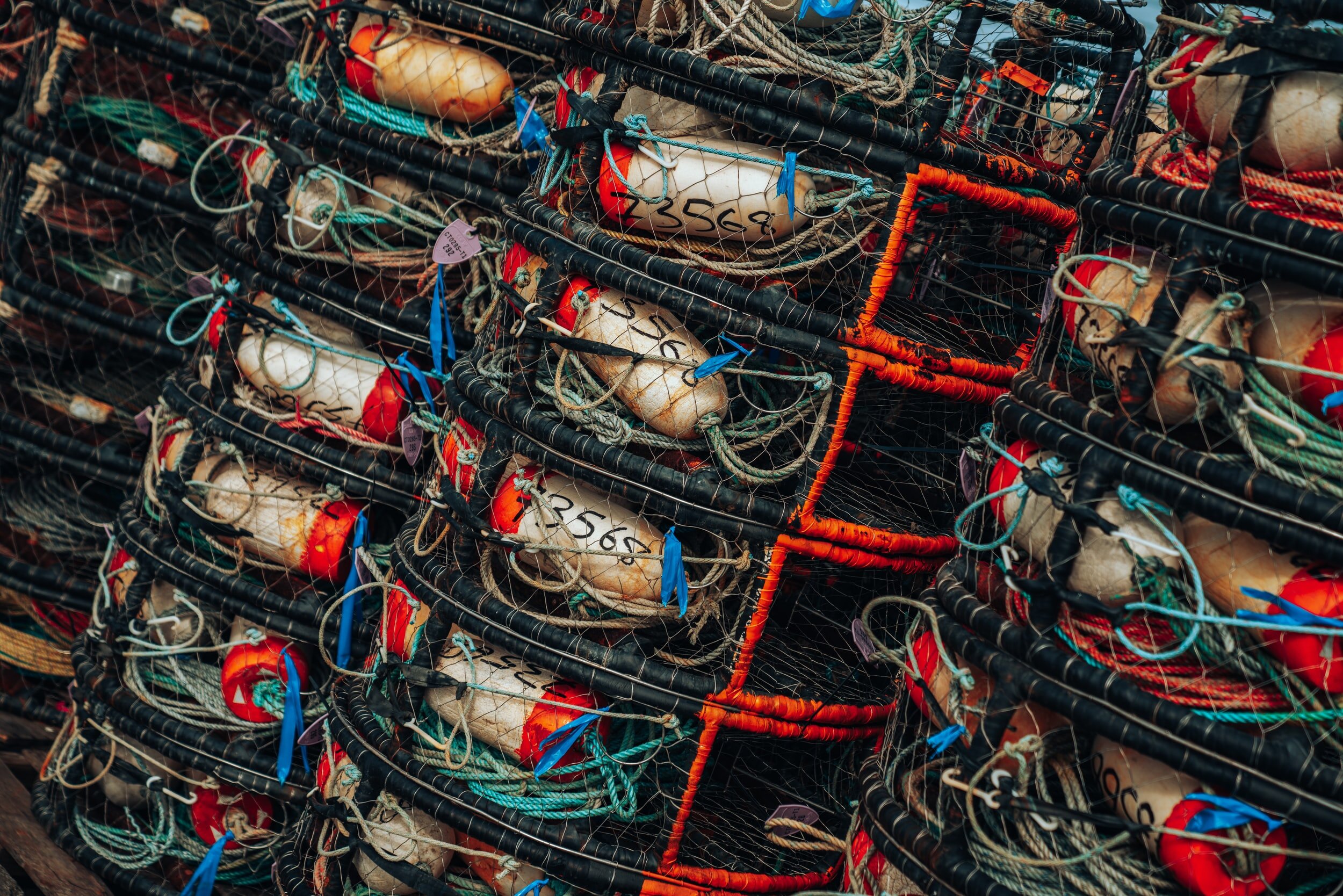Global Overfishing and the Collapse of Fisheries
Commercial fishing is protected and promoted by governments and fisheries councils because it is seen as an industry that provides food and jobs. What isn’t always mentioned is the fact that in most countries it has to be subsidized to continue. The problem is that this abuse is not readily seen by most of us. What happens out at sea goes on sight unseen.
If we would see the devastation that happens every single day, we would be more outraged and demand a change immediately. We have technology, data and ingenuity to create better methods. What is needed is global awareness and involvement, and the political will to work in the interest of a sustainable future.
This is an incredibly complex topic. Here are the most important facts and links to further reading:
An estimated 70% of fish populations are fully used, overused, or in crisis as a result of overfishing and warmer waters.
190 billion pounds of fish, an excellent article by Becky Bauer on AllAtSea.net.
The Census of Marine Life concluded in 2010 that 90% of the large fish are gone, primarily because of overfishing.
It has been estimated that between 0.97 to 2.7 trillion fish are caught from the wild and killed globally every year, read more here.
Estimating the number of fish caught in global fishing each year, along with animal welfare implications, found here.
20-32% of wild-caught seafood imported into the U.S. comes from illegal fishing, dive in here.
INDUSTRIAL FISHING METHODS ARE DESTROYING OUR OCEANS
BOTTOM TRAWLING
This is by far the most destructive fishing practice, mega-sized trawling nets can catch more than 500 tons of fish in one pass. In the process destroying the sea floor by dragging heavy equipment across the ocean floor, essentially roto tilling everything in it’s path.
According to Ibrahim Thiaw, Director General of the World Conservation Union, 80% of the catch brought up in one haul of a bottom trawl net is by-catch and thrown dead or dying back into the sea. Elias Chin, Vice-President of the Pacific island of Palau, stated recently that bottom trawling is responsible for 95% of the destruction of underwater habitats. The UN Food and Agricultural Organization’s statistics compiled over many years demonstrates that a mere 0.5%, one half of one percent, of global fish catches is contributed by bottom trawling operations yet those operations are responsible for the devastation of 2.4 billion acres of sea bottom each year.
Bottom trawling and dredging destroys 150 times more sea bottom than clear cutting destroys forests per year. That equates to 150x16,000,000 = 2,400,000,000 acres of sea bottom per year; a number so large as to be almost incomprehensible. Click here.
Recent scientific work outlines the severe consequences the practice of bottom trawling has on loose sediment on the ocean floor.
Several studies have shown the significant impact that trawling has on ecosystems, killing corals, sponges, fish and other animals. Bottom trawling for fish stirs up billowing plumes of sediment that can be seen from space and destroys entire seafloor ecosystems.
LONGLINE FISHING
Longline fishing is a fishing method where long fishing lines, containing thousands of baited hooks, are deployed in the open ocean to catch pelagic fish such as swordfish and tuna. They are left to drift, or “soak”, often for days, to attract fish. Unfortunately, many other animals end up getting hooked and ensnared. For example, it has been estimated that global longline fisheries kill somewhere between 160,000 and 320,000 seabirds annually. That unintended catch is called bycatch, which we will cover in more detail in the next blog.
In the longline tuna fishery approximately 5 million hooks get set each day on 100,000 miles of line. That is enough line to wrap around the entire globe four times every day. Longlines also pose a threat if they are lost or discarded at sea, where they will drift and ensnare animals sometimes for years, or until they finally degrade enough into smaller pieces, at which point they contribute to the overall plastic pollution that clogs up our ocean. Please reference this video to learn more on longline fishing.
PURSE SEINE FISHING
Purse seine nets can be more than 1,000 feet in length. They are deployed around schooling fish, such as sardines, anchovy and tuna. When the nets are closed they scoop up everything that is within its circle. Because they are often set around floating debris or FADs (Fish Attractive Devices), where fish like to gather and juveniles find cover, the nets end up trapping and killing many oceanic species that are discarded as “incidental” or “unintended” bycatch, including dolphins, sharks, sea turtles and many undersized fish and many creatures that were using the FAD or debris pile as a habitat or for cover from other predators. Purse seine fishing is an indiscriminate way of fishing that produces a huge amount of waste. It has put enormous pressure on fishing populations because it allows fisheries to take out too many fish, day after day. Click here for further reading, and reference this video to learn more about purse seine fishing.
DRIFT GILLNETS
Gillnets are walls of netting that drift (“drift” gillnets) or are anchored (“set” gillnets) in the water, designed so that fish get stuck around their gills when they try to swim through. The netting can be up to two miles long and anchored hundreds of feet deep or left floating at the surface. Though researchers work to develop ways of reducing entanglement in gillnets, this gear has been banned on the high seas by the United Nations, as well as by many other countries.
NOAA states, “Mesh sizes are designed to allow fish to get only their head through the netting but not their body. The fish's gills then get caught in the mesh as the fish tries to back out of the net. As the fish struggles to free itself, it becomes more and more entangled.” Gillnets inflict a lot of damage and are banned in many places. In some areas the size of the mesh is restricted to allow for smaller fish to swim through. But that does not address the many animals, anything from whales, dolphins and sharks to sea turtles and sea mammals that get trapped and killed in these curtains of death.
According to NOAA, the California Thresher Shark and Swordfish Drift Gillnet Fishery, “consists of a 1,000 fathom (1,829 m) gillnet with stretched mesh size from 18-22 in (45.7-56 cm), with a 14 in (35.6 cm) minimum. The net is set at dusk and allowed to drift during the night, with the fishing vessel typically attached at one end of the net. The soak duration is typically 12-14 hours depending on length of the night. Net extender lengths of a minimum 36 ft (11 m) became mandatory for the 1997-1998 fishing season, and the use of acoustic warning devices (i.e., pingers) became mandatory October 28, 1997, significantly decreasing cetacean entanglement. To learn more about drift gill nets, here is a description of methods, the FAO’s description of gillnet fishing, and a helpful video to visualize.
SUPPORT THE DRIFTNET MODERNIZATION AND BYCATCH REDUCTION ACT
FISHERIES MANAGEMENT
There are many problems with the way fisheries are currently managed by government authorities. It starts with the fact that fish are categorized strictly as a resource. A bulk food that exists simply for the taking until critical levels are reached. Sustainability is judged by how fishing numbers turn out every year. Very little consideration is given to the intricate balance fish populations play in the larger oceanic system. As long as the same amount of a species can be caught every year, it is deemed a “sustainable” fishery. Fisheries scientists will oppose this point of view by saying it is an oversimplification. Clearly, there is more to the science of fisheries management than counting fish. But from the point of view of conservation, the constant argument supporting commercial take and the reluctance to protect species or whole areas from fishing always comes down to claims that there still are enough fish as evidenced by catch rates.
Fisheries management councils, in many cases, work to keep commercial fishing alive and booming. They rarely make conservation, or subsistence-level fishing a priority. Often these management councils are given the exclusive authority to make decisions on fishing policies and regulations, without there being any balancing conservation minded authorities within the government. The state of our oceans and the collapse of global fisheries is clear proof that this system is not working. Together, these mechanisms are the reason for weak regulations and a lack of enforcement. Add that to rampant illegal, unreported, and unregulated (IUU) fishing and the result is the massive over-fishing of all marine species.
MARINE PROTECTED AREAS
According to the U.N.’s World Database on Protected Areas, 7.5% of the ocean is protected. But how accurate are these figures? And how protected are those areas? “MPA” has become a catch-all term for the many forms of management applied to the ocean, but it means different things to different people. The Marine Conservation Institute and its Atlas of Marine Protection, shows about 5% of the ocean managed in true MPAs. Read more about this topic here.
GHOST NETS
The fishing methods described above all have an additional deadly effect – their continued impact once they are intentionally discarded or lost at sea. Giants balls of line, tangled up gear and nets float for years along the ocean currents, trapping and killing animals day after day, until they get stuck on a coral reef, ensnaring plants and animals, or break down into smaller pieces that float ashore, sink to the deep or become part of the plastic soup that is polluting our oceans. 46% of the plastic in the great pacific garbage patch by weight came from fishing nets.
SUBSIDIES
Estimates show that of the $35.4 billion of global fisheries subsidies provided in 2018, 19% went to the small-scale fishing sub-sector (SSF), including artisanal, and subsistence fisheries. Whilst more than 80% went to the large-scale (industrial) fishing sub-sector (LSF). It is time for governments to act and end harmful fishing subsidies. Stopping some payments would improve ocean health, economies, and food security worldwide. Not all subsidies are bad. Some, for instance, help countries better manage their fisheries or protect areas of the ocean that serve as fish breeding grounds. It’s critical that these subsidies remain in place.
However, governments pay more than $22 billion a year in damaging types of subsidies, known as capacity-enhancing subsidies, to offset costs such as fuel, gear, and vessel construction. Read more here. More than 160 leading environmental organizations have signed on in support of ending these unsustainable funding practices and are requesting that the WTO (World Trade Organization) take action. You can support the campaign here https://stopfundingoverfishing.com/.
All of us need to worry about marine resources. It is time to ask our government agencies to acknowledge their failure and to hold them to the task of developing regulations and enforcement that works in the interest of sustainability instead of only looking out for short-term commercial profitability. Many organizations around the world are working to address these problems. We will try to do our part by raising awareness and by engaging the public through our campaigns, and we will collaborate in every way possible with conservation groups, leaders, and policymakers to find solutions and support for these issues. As an immediate step, we must support the establishment of marine sanctuaries and protected areas around the world, which are not only a haven for marine life but also our best chance to replenish fish populations.

